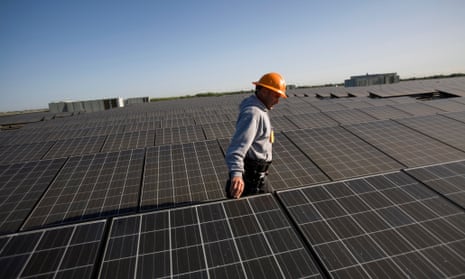Solar company SunEdison last week said it plans to provide low-cost solar electricity to 20 million people around the world living without electricity or with inconsistent access to electricity.
By the end of 2015, the company said it expects to have extended service to 1 million off-the-grid customers. To do this, it is working with a variety of government organizations, businesses and NGOs, including financing partners OPIC, Arc Finance and the World Bank, and installation and maintenance partners SunFarmer, GridAlternatives, Solaric and Omnigrid Micropower.
The announcement came on the heels of a summit, held last week in New York City, aimed at “eradicating darkness” around the world. Attendees discussed potential partnerships that could make this goal a reality, but no other announcements resulted immediately.
As Paris climate talks approach in November, the question of how poor countries can grow their economies without proportional growth in emissions is a hot issue – and electricity is a major part of that challenge. The World Bank estimates that 1.2 billion people lack electricity around the globe, with many more dealing with inconsistent access, while 2.8 billion still rely on wood or other biomass – instead of gas or electricity – for cooking and heating.
Half the world in the dark
Nearly half the world’s population of 7 billion has insufficient access to electricity. Apart from the oft-cited safety and education concerns, this lack of access leads to a host of problems, from an inability to pump water for irrigation to a lack of access to vaccines, many of which have to be refrigerated.
At Tuesday’s conference, Anita George, a senior director at the World Bank, said these difficulties and hazards multiply in surprising ways. Cooking with health-damaging solid fuels, for example, leads to 4.3 million deaths per year.
Inconsistent or nonexistent access to electricity can also shut the door on many other advantages of the modern world. For example, while smartphones have the ability to link billions of people to the internet and the global financial system, an inability to easily and cheaply recharge them effectively limits or eliminates that access.
Some experts have suggested that solar power – potentially funded by large corporations, as prices have fallen – could help play a significant role in electrifying places without a reliable grid today without pushing the earth’s temperatures above 2C.
After all, traditional electrical grids require expensive infrastructure. The high construction cost of large electrical grids keeps them from extending into poor, remote communities, said Elizabeth Littlefield, CEO of the US Government’s Overseas Private Investment Corp. Underserved communities “will never get power through a grid”, Littlefield said at the summit. “And we’d better hope that they don’t get it from fossil fuels.”
Solar power, on the other hand, offers the potential for low-cost, decentralized power generation. Solar generation is now roughly comparable to other fuels in many markets, according to Stanford law professor Stefan Heck. Because it can be generated close to end users, solar power also doesn’t require an expensive power grid to reach remote places.
To meet its goal of bringing electricity to 20 million people, SunEdison has developed a product called the Outdoor Microstation 3500. The microstation can generate up to 7.9 kilowatt-hours per day – enough to supply street lighting and five hours of electricity per night for 25 average households – can be monitored remotely around the clock, and includes a battery that can store up to 23.7 kilowatt-hours, so it doesn’t need to be connected to a grid.
Other companies and social enterprises have also sprung up with a variety of green lighting products for developing countries.
Pitfalls ahead
But solving the problem will require far more financing, as well as the resolution of a daunting series of technological, political, cultural and logistical barriers.
Prior electrical initiatives in developing countries have proven that new technologies are only useful if they can be distributed to the people who need them, and if they can be maintained after they’ve been installed.
As the Energy Collective recently reported, solar power maintenance is often underemphasized, and not directly planned for during planning and installation stages.
Those bringing lighting to developing countries or conflict areas often run into similar issues: when the lights break down – or, as in the case of Global BrightLight Foundation’s efforts to distribute solar lanterns to refugees in Rwanda, they don’t work in the first place – often no plans are in place to fix them. These electrification efforts, while helpful, are often not self-sustaining.
It’s clear that rolling out solar power en masse in developing countries will require new business models to install, maintain and repair the systems.
But if these issues can be solved, the hope is that solar could become a “lightbulb” technology, with the potential to transform world economics and society, Heck said at the event on Tuesday.
When electricity came to New York, Heck said, “human productivity went through the roof,” leading to a 13-fold increase in GDP per capita.
If, as SunEdison hopes, 20 million people, spurred by cheap solar, experience that same increase in productivity within the next five years, the impact could be stunning – and, hopefully, sustainable.
The role of business in development hub is funded by Business Call to Action. All content is editorially independent except for pieces labelled “brought to you by”. Find out more here.
